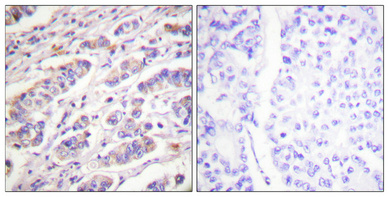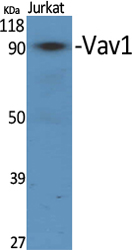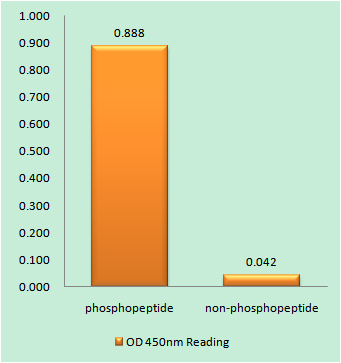Vav (phospho Tyr174) Polyclonal Antibody
- 货号:YP0273
- 应用:WB;IHC;IF;ELISA
- 种属:Human;Mouse;Rat
- 靶点:
- VAV1
- 简介:
- >>Rap1 signaling pathway;>>cAMP signaling pathway;>>Chemokine signaling pathway;>>Focal adhesion;>>Natural killer cell mediated cytotoxicity;>>T cell receptor signaling pathway;>>B cell receptor signaling pathway;>>Fc epsilon RI signaling pathway;>>Fc gamma R-mediated phagocytosis;>>Leukocyte transendothelial migration;>>Regulation of actin cytoskeleton;>>Yersinia infection;>>Proteoglycans in cancer;>>Lipid and atherosclerosis
- 基因名称:
- VAV1
- 蛋白名称:
- Proto-oncogene vav
- Human Gene Id:
- 7409
- Human Swiss Prot No:
- P15498
- Mouse Gene Id:
- 22324
- Mouse Swiss Prot No:
- P27870
- Rat Swiss Prot No:
- P54100
- 免疫原:
- Synthesized phospho-peptide around the phosphorylation site of human Vav (phospho Tyr174)
- 特异性:
- Phospho-Vav (Y174) Polyclonal Antibody detects endogenous levels of Vav protein only when phosphorylated at Y174.
- 组成:
- Liquid in PBS containing 50% glycerol, 0.5% BSA and 0.02% sodium azide.
- 来源:
- Polyclonal, Rabbit,IgG
- 稀释:
- WB 1:500 - 1:2000. IHC 1:100 - 1:300. ELISA: 1:5000.. IF 1:50-200
- 纯化工艺:
- The antibody was affinity-purified from rabbit antiserum by affinity-chromatography using epitope-specific immunogen.
- 浓度:
- 1 mg/ml
- 储存:
- -15°C to -25°C/1 year(Do not lower than -25°C)
- 其他名称:
- VAV1;VAV;Proto-oncogene vav
- 实测条带:
- 100kD
- 背景:
- This gene is a member of the VAV gene family. The VAV proteins are guanine nucleotide exchange factors (GEFs) for Rho family GTPases that activate pathways leading to actin cytoskeletal rearrangements and transcriptional alterations. The encoded protein is important in hematopoiesis, playing a role in T-cell and B-cell development and activation. The encoded protein has been identified as the specific binding partner of Nef proteins from HIV-1. Coexpression and binding of these partners initiates profound morphological changes, cytoskeletal rearrangements and the JNK/SAPK signaling cascade, leading to increased levels of viral transcription and replication. Alternatively spliced transcript variants encoding multiple isoforms have been observed for this gene. [provided by RefSeq, Apr 2012],
- 功能:
- domain:The DH domain is involved in interaction with CCPG1.,function:Couples tyrosine kinase signals with the activation of the Rho/Rac GTPases, thus leading to cell differentiation and/or proliferation.,miscellaneous:'Vav' stands for the sixth letter of the Hebrew alphabet.,PTM:Phosphorylated on tyrosine residues.,similarity:Contains 1 CH (calponin-homology) domain.,similarity:Contains 1 DH (DBL-homology) domain.,similarity:Contains 1 PH domain.,similarity:Contains 1 phorbol-ester/DAG-type zinc finger.,similarity:Contains 1 SH2 domain.,similarity:Contains 2 SH3 domains.,subunit:May interact with CCPG1 (By similarity). Interacts with APS, DOCK2, GRB2, GRB3, DOCK2, SLA and ZNF655/VIK. Interacts with SIAH2; without leading to its degradation. Associates with BLNK, PLCG1, GRB2 and NCK1 in a B-cell antigen receptor-dependent fashion. Interacts with CBLB; which inhibits tyrosine phosphorylati
- 细胞定位:
- intracellular,cytosol,plasma membrane,cell-cell junction,
- 组织表达:
- Widely expressed in hematopoietic cells but not in other cell types.
- June 19-2018
- WESTERN IMMUNOBLOTTING PROTOCOL
- June 19-2018
- IMMUNOHISTOCHEMISTRY-PARAFFIN PROTOCOL
- June 19-2018
- IMMUNOFLUORESCENCE PROTOCOL
- September 08-2020
- FLOW-CYTOMEYRT-PROTOCOL
- May 20-2022
- Cell-Based ELISA│解您多样本WB检测之困扰
- July 13-2018
- CELL-BASED-ELISA-PROTOCOL-FOR-ACETYL-PROTEIN
- July 13-2018
- CELL-BASED-ELISA-PROTOCOL-FOR-PHOSPHO-PROTEIN
- July 13-2018
- Antibody-FAQs
- 产品图片

- Immunohistochemical analysis of paraffin-embedded Human breast cancer. Antibody was diluted at 1:100(4° overnight). High-pressure and temperature Tris-EDTA,pH8.0 was used for antigen retrieval. Negetive contrl (right) obtaned from antibody was pre-absorbed by immunogen peptide.

- Immunohistochemistry analysis of paraffin-embedded human breast cancer, using VAV1 (Phospho-Tyr174) Antibody. The picture on the right is blocked with the VAV1 (Phospho-Tyr174) peptide.


